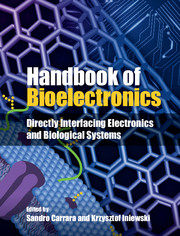Book contents
- Frontmatter
- Contents
- List of Contributors
- 1 What is bioelectronics?
- Part I Electronic components
- Part II Biosensors
- 8 Introduction to biosensors
- 9 CNT and proteins for bioelectronics in personalized medicine
- 10 CMOS nanowire biosensing systems
- 11 Cell-array biosensors
- 12 System-on-a-chip pulse radar for contactless motion sensing in human–machine smart interfaces
- 13 MagCMOS
- 14 Metamorphic neural interfaces with insects for remote controlled biobots
- Part III Fuel cells
- Part IV Biomimetic systems
- Part V Bionics
- Part VI Brain interfaces
- Part VII Lab-on-a-chip
- Part VIII Future perspectives
- Index
- References
11 - Cell-array biosensors
from Part II - Biosensors
Published online by Cambridge University Press: 05 September 2015
- Frontmatter
- Contents
- List of Contributors
- 1 What is bioelectronics?
- Part I Electronic components
- Part II Biosensors
- 8 Introduction to biosensors
- 9 CNT and proteins for bioelectronics in personalized medicine
- 10 CMOS nanowire biosensing systems
- 11 Cell-array biosensors
- 12 System-on-a-chip pulse radar for contactless motion sensing in human–machine smart interfaces
- 13 MagCMOS
- 14 Metamorphic neural interfaces with insects for remote controlled biobots
- Part III Fuel cells
- Part IV Biomimetic systems
- Part V Bionics
- Part VI Brain interfaces
- Part VII Lab-on-a-chip
- Part VIII Future perspectives
- Index
- References
Summary
Introduction
The field of electrophysiology explores the mechanisms of electrical signalgeneration and propagation in living tissues. Contemporary electrophysiologyhas tended to focus on electrically excitable cells, for example observingaction potentials propagating along a neuronal membrane. However, the birthof electrophysiology was concerned with a more global approach, looking at“bioelectricity” in the whole organism. Galvani, the father of“bioelectricity”, hooked up lightning rods to cut nerves in afrog’s leg and observed twitching of the leg muscles during alightning storm. Matteucci, in 1831, was the first to measure the so-called“injury potentials” using a galvanometer in a cut nerve endingand demonstrated the existence of action potentials in nerves and muscles.His work was extended by Du Bois-Reymond, who in 1843 was able to directlymeasure the propagation of action potentials and also the injury potentialsfrom cuts in his own finger. While rapid changes in membrane conductance ofindividual cells may be viewed as a somewhat “obvious” targetthat has been intensely studied, other, slower bioelectric phenomena such asthose seen in wound healing have been somewhat neglected. The field of“bioelectricity” has seen a re-emergence in the past decade,thanks in part to new techniques in molecular physiology. In addition, theensemble of electric phenomena in biology is rarely considered. Instead ofsolely focusing on action potentials in individual cells, it can beinstructive to consider electrical characteristics in groups or arrays ofcells. In this chapter we focus on the electrical measurement of arrays ofcells or tissue layers. We attempt to widen the traditional definition ofelectrophysiology in a more general sense, as the electrical measurement ofion flow in biological systems. We review a subset of literature on methodsfor measuring ion flow in tissues in vitro in bothelectrically active and non-electrically active cells. We will particularlyhighlight dynamic methods for monitoring cell cultures, and the new trend ofusing transistors rather than simple electrodes with a special emphasis onthe use of conducting polymers to do so.
Information
- Type
- Chapter
- Information
- Handbook of BioelectronicsDirectly Interfacing Electronics and Biological Systems, pp. 137 - 154Publisher: Cambridge University PressPrint publication year: 2015
